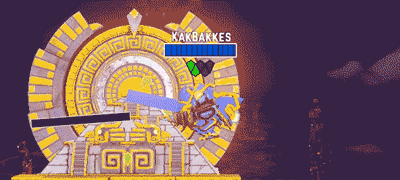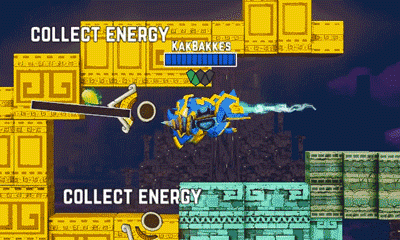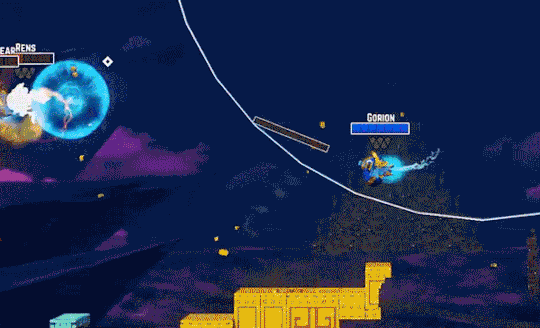Trending
Opinion: How will Project 2025 impact game developers?
The Heritage Foundation's manifesto for the possible next administration could do great harm to many, including large portions of the game development community.

Featured Blog | This community-written post highlights the best of what the game industry has to offer. Read more like it on the Game Developer Blogs or learn how to Submit Your Own Blog Post
In this Antegods development update our Designer Wytze talks us through the process of creating game pillars which are used frequently and aid with deciding on new functionality or making changes to the game.

If you are interested in seeing how the changes described below impacted the game then you can check out the results for yourself in a recent Playtest and chat with us directly at discord.codeglue.com
Watch live video from CodeglueGames on www.twitch.tv
An Intro to the pillars
Throughout development of Antegods each of us has had their ideas on what Antegods is and should be. Aspiring to these goals has gotten us far, but recently we’ve had some difficult choices about the direction of the game.
JP suggested that we set up design pillars. A design pillar is basically a sentence that captures an essential part of your game: not a mechanic or a system, but a part of the player experience. This seemed like a great idea, so I set out and formulated the following Antegods design pillars:
Fluid skill-based gameplay
Titan as strategic backbone leading to an epic conclusion
Work as a team and combine your strengths
Short action-packed matches
I’ve done an elaborate analysis of Antegods in its current state and how much the game is achieving the design pillars. The full analysis is about 6 pages long, so I’ve picked some of the more important conclusions for you.
Analysis for this pillar will be done on a per-mechanic basis, as the fluid skill-based gameplay should be in every aspect of the game.
Flying & Dashing
Flying in Antegods’s low-gravity environment feels quite fluid. The dash is also important to fluidity: it adds a certain rhythm to the gameplay and also lets you fly through destructible terrain while hardly slowing down. It’s also nice to time your dash and shot together, either to do last-minute repositioning or to give extra speed to your projectile.

What doesn’t feel good is when you get stuck behind a small piece of leftover destructible terrain. It both interrupts smooth movement and frustrates because it doesn’t feel fair, especially when you don’t see the leftover bits of terrain.
Weapons

Weapons can add a lot to the rhythm and fluidity of gameplay. The drill lets you slice through terrain very easily and forces you to track your enemy constantly. The shotgun has a very bursty up-close playstyle and requires you to use your dash smartly. The grenade launcher and railgun are less fluid; launched grenades are less affected by the player’s movement speed than before; and the railgun fires less often and has a charge-up time. Both of these weapon’s flow should be improved.
Dying & Respawning
The respawn time is one of the foremost non-fluid moments, as you’re literally not doing anything while looking at the position where you got destroyed for 12 seconds (or 10-20 seconds with the new changes).

Another frustrating moment is when you respawn in a position where you’re mostly stuck in terrain, which can happen if the Titan’s placed near terrain.
Gathering energy from Spindle point
We recently made a change to the Spindle Point. The old Spindle Point would generate energy passively every 40 seconds. The new Spindle Point only generates energy if there’s a player nearby.

The new mechanic does add a lot of skill to the game, although only on a strategical level: who goes where to generate energy and when? It has a big impact on the overall flow of the game, but the downsides are quite big currently.
The change forces players to stay at the Spindle for up to 20 seconds without having anything to do, except maybe fight off enemies. This is currently the biggest disruption in game flow, taking even more time than respawning, and should definitely be looked into.
Gathering energy from the world
The gathering of energy is quite fluid and skillful, as you have to find the quickest path through terrain to gather the energy and if you want to keep moving, you have to think ahead about your next move. It makes full use of the destructible terrain dynamics.

The Titan’s already strategically important, but only in a few limited ways.
The Titan’s first and foremost purpose is to respawn the players. Throughout the entire game you can use the Titan to reposition the spawning location to help pressure different parts of the level. Usually this means at the start of the game you place it near a friendly region close to the turn-in point.
Then throughout most of the match you don’t move it anymore, until your or the opposing Titan is fully powered. If yours is fully powered you move it forward to attack the enemy Titan, if the enemy Titan is fully powered you retreat to one of your regions to buy as much time as possible.
You’re lacking interesting options throughout the middle part of the match, because you can only use the Titan for its short-range shockwave and or as a big meat shield. The risk of receiving permanent damage to your Titan rarely pays off.

The Titan battle also isn’t an epic enough conclusion currently. Oftentimes attacking team is the one that loses. The tactics you can use are limited: position your Titan so your shockwave can hit their gunner or pilot; shoot their gunner and pilot to reduce their damage; keep on dealing damage to the enemy Titan so it can’t regenerate its shield. On a strategic level you have to choose when to attack and when to retreat and make good use of the regions.
The regions actually have a larger strategic impact on the match than your Titan currently. Regions dictate which areas of the level are safe to retreat to, where you can safely position your Titan, and whether or not the enemy team can advance onto your Titan safely. Throughout the entire match the regions are contested, whereas the Titan’s sparsely used until the very end.
This is the design pillar we’ve accomplished the best so far: working in a team is very important in Antegods.
When battling the team who has the most mechs around usually wins. Thus keeping an eye on where your teammates are and supporting each other when someone’s battling is a very important way of working together.
Players can also defend their teammates when they’re trying to deliver energy or escaping from battle. By selflessly blocking incoming projectiles and scaring away enemies your teammates can safely dump their energy or retreat. Additionally when trying to capture a region it’s a lot safer when there are at least two players, because together you can both deliver 5 energy of the 10 energy required.
We recently added abilities to the mechs, hoping to create more skillful options for teamplay. For example, the Turtle shield allows you to place a barrier of destructible terrain, which I hoped would be used for blocking enemies, intercepting projectiles and creating a safe route for escape. During the playtesting of prototype character abilities we’ve seen this emphasis on teamwork with some epic moments happening in matches.

The new spindle point mechanics also speed up the energy spin process for every nearby player. You can save a lot of time by helping each other out at a spindle for a short time.
Finally a fully powered Titan requires two players to control its full capabilities. Plus it’s wise to have the other two players nearby the Titan as well to defend the pilot and gunner from enemy mechs.
We have successfully designed and balanced Antegods so matches are usually quite short with a duration of 10-12 minutes. Having one fully powered Titan usually forces the match to end within a few minutes, as it will be used to attack the enemy regions and Titan. Lately there have been matches that take a lot longer due to a stalemate between two teams with fully powered Titans. The end of these matches is usually very drawn out with neither team having good options to deal enough damage to the enemy Titan.
We hope to fix this by allowing teams to ‘overcharge’ their Titan: when delivering energy to a fully powered Titan, it gains temporary shields or an extra powerful weapon. This would allow the teams to gain an advantage over their opponent and push forward to victory.

Throughout most of the match there’s a lot of action happening with regular conflicts over delivering energy, attacks on regions and the gathering of energy. The problematic moments without any action are waiting to respawn and gathering energy from the new spindle points.
Based on all of this analysis it seems we have quite some work to do to make some mechanics in the game more fluid and make the Titan a more important and interesting entity throughout the match. Whenever we’re adding new features or making changes those will be based on these pillars, so expect to hear more about them in future blog posts.
To follow our development updates, please check us out on Discord, Tumblr, Twitter or Facebook. And don’t forget to subscribe to our newsletter for info on events and sales.
Antegods is supported by the Dutch Cultural Media Fund, Cultural Industries Fund NL and the MEDIA Programme of the European Union.


Read more about:
Featured BlogsYou May Also Like